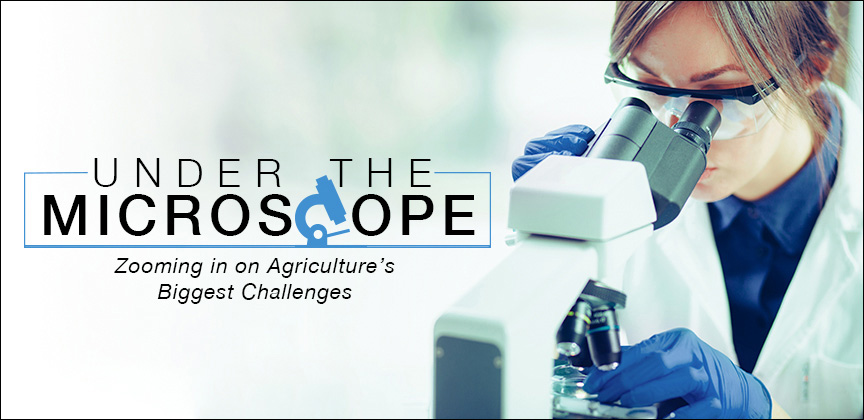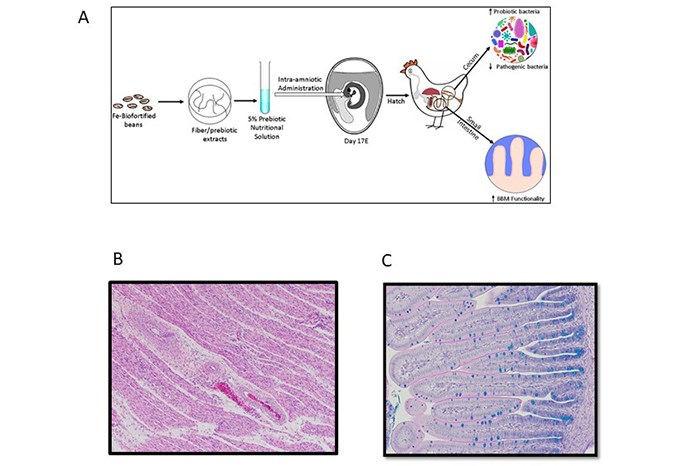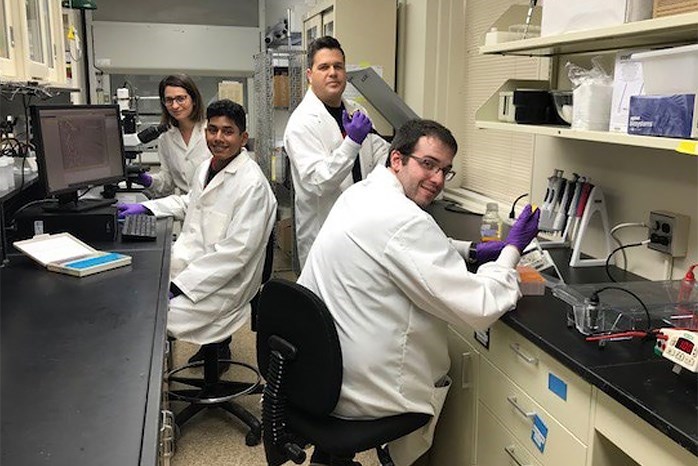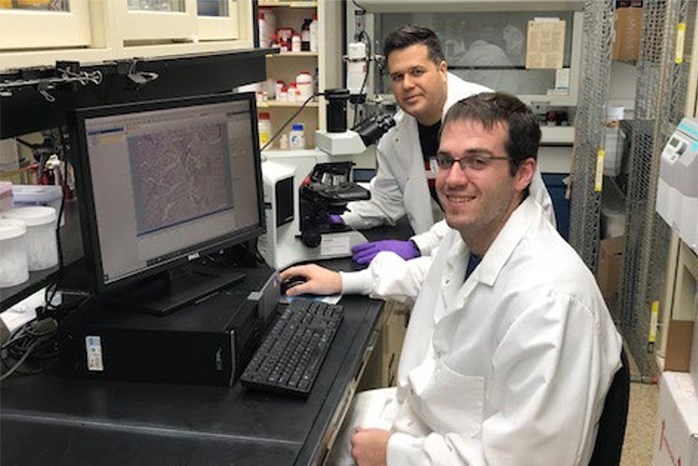
Addressing Iron and Zinc Deficiency Across the Globe
 |
Dr. Elad Tako is a research physiologist at ARS's Robert W. Holley Center for Agriculture and Health in Ithaca, NY. He recently presented at the Beltsville Human Nutrition Research Center on the subject, "Improving Food Security with Iron-Enriched Cereal Crops." |
Welcome Dr. Tako to Under the Microscope.
UM – Let's start by talking about the health benefits of zinc and iron, two minerals that Americans, and the world, often do not consume enough of. Why do our bodies need zinc and iron and what are the health risks associated with deficiency?
ET: Iron and zinc hold key roles in numerous metabolic processes in the body. Zinc and iron dietary inadequacies have been associated with stunted growth, impaired physical and cognitive development, anemia, depressed immune function, increased vulnerability to and severity of infection, adverse outcomes of pregnancy, and neurobehavioral abnormalities. Deficiencies of iron and zinc are major causes of early childhood morbidity and mortality, primarily in developing countries.
UM – Over 2 billion humans are iron and zinc deficient, a staggering number. Why are so many people deficient globally, and how is your research benefitting communities most at risk?
ET: Iron deficiency affects around 40 percent of the world's population, particularly women and children in developing countries. Iron deficiency is highly prevalent in low-income countries due to a lack of meat consumption and a notable dietary reliance on grains containing high amounts of iron absorption inhibitors. In the United States, approximately 10 million people are iron deficient.
Our research is focused on developing and using tools to investigate and understand how we digest and absorb certain foods, and their interaction with microbials in our body, so we can better strategize potential nutritional approaches aimed at alleviating dietary deficiencies in specific populations.
UM – Your research uses a novel approach to identifying food crops rich in zinc and iron, please explain.
ET: In order to identify iron dietary bioavailability, we are using a combined approach of in vitro and in vivo models to assist in the developing process of staple food crop varieties and predict their effect on iron and zinc status in humans. For example, we observed that the broiler chicken model exhibited similar responses to iron and zinc deficiencies as a human and thus may be useful as a model for iron and zinc bioavailability and absorption in humans. Further, we use novel physiological, molecular, morphological, and microbial biomarkers to assess dietary effects on iron and zinc nutrition.
Specifically with zinc, researchers have had difficulty creating biological markers to determine mild to severe levels of deficiency. I developed a novel biomarker of zinc status that can be used as an additional indicator for assessing zinc status more precisely in humans. This is a key development in the field of zinc nutrition, and will allow for a more accurate assessment of a subject's zinc physiological status due to dietary intervention and in the context of zinc enhanced staple food crops.

In his research, Dr. Tako is using the broiler chicken model to assess the effects of plant origin bioactive compounds (as fiber) on intestinal functionality, and microbial populations (A). Tissue samples are collected for histological and morphometric measurement and in order to assess a dietary effects on muscle growth (B), and small intestinal development.
UM – How is your research changing the world's diet to ensure humans are consuming more nutrients like iron and zinc?
ET: By highlighting the importance of dietary zinc and iron for various metabolic pathways, we can further demonstrate their key role when included in a balanced diet. For example, we were able to demonstrate that iron deficiency is affecting the intestinal microbial populations, which may lead to increased vulnerability for measles, influenza A, hepatitis C, and staphylococcus infection. Similarly, zinc deficiency also affects the intestinal microbial profile, and this effect may lead to reduced digestive and absorptive functions of the small intestine.
This is a collaborative effort with ARS scientists and domestic and international research institutions to try to alleviate iron and zinc deficiencies in vulnerable populations. Our overall goal is to increase the knowledge related to iron and zinc nutrition and better understand how factors such as prebiotics, bioactive compounds (as polyphenols), and the intestinal microbiome may affect dietary iron and zinc availability and absorption.

ARS scientist, Elad Tako (back right), and laboratory technician, Nikolai Kolba (front right), prepare samples to be run on a qPCR system aimed to asses intestinal proteins expression. Student Dasun Priyawardhana (front left), and visiting professor (Hercia Martino) are measuring intestinal villi size, and goblet cells diameter.
UM – Eating more foods rich in iron and zinc is important, but absorption also plays a key factor, correct?
ET: Correct. Certain foods high in phytic acid and polyphenols chelate iron and zinc (i.e., dark colored beans) limit these minerals' dietary availability and absorption, while foods high in ascorbic acid (citrus fruit, cantaloupe, strawberries, raspberries, blueberries, and cranberries), and fermentable fiber (legumes) increase iron and zinc availability and absorption. This is especially relevant in populations that rely on staple food crops as their main sources of dietary iron and zinc because these populations may not be getting enough foods with high zinc and iron absorption properties.
UM – We are all learning about the vital role of the gut microbiome to our health. What has your research found with regards to the microbiome, and what should Americans eat more of to ensure a healthy gut?
ET: The human intestine harbors a complex and dynamic gut microbiota, heavily influenced by host genetics, environment, and diet. The gut, which houses the majority of these microbes, is an important organ in the absorption of micronutrients (such as zinc and iron) from the diet. We have demonstrated that severe zinc deficiency negatively affects the composition of the intestinal microbial populations, and an iron deficient microbial profile may lead to increased chances to develop influenza A, measles, and hepatitis C.
In order to ensure a healthy gut and a healthy microbiome, it is vital to include food sources that are rich in fiber (such as whole grains, fruits, and vegetables). Dietary fiber survives the initial digestion in the stomach and upper intestine, and "feeds" health promoting bacterial populations that mostly reside in the lower intestine and colon.

In order to assess the dietary effects on the intestinal brush border membrane morphology, ARS physiologist, Elad Tako (back) and Biological Laboratory Technician (Nikolai Kolba) use a microscopic system.
UM – How do prebiotics and probiotics work in concert to maintain a healthy gut, and where can people find these in their everyday foods?
ET: Prebiotics are non-digestible food ingredients that selectively promote the proliferation and/or activity of health-promoting bacterial populations (probiotics) in the intestinal colon and, thereby, exert a health-promoting effect and decrease the risk of chronic diseases.
In studying pre and probiotics, my research team has demonstrated that fiber extracted from chia seed, beans, wheat, wheat bran, lentil, and chickpea positively affected the small intestinal digestive and absorptive surface functionality and development, and increased the abundance of health promoting bacterial populations (probiotics).
UM – How can people with celiac disease, wheat allergies, or wheat-free diets still consume enough foods rich in zinc and iron?
ET: Indeed food/grain allergies and conditions like celiac disease may limit the consumption of grains, primarily wheat. However, other sources such as legumes can certainly provide plant-origin food alternatives/additions that are rich in micronutrients (mineral and vitamins), fiber, and protein. These include, chickpea, beans, lentils, and peas. Beans, chickpea, and lentil flours are now being used as wheat flour alternatives in baked goods, breads, and even pasta products.
UM – I'm sure people who learn what you do for a living probably ask, "what should I be eating more of?" What do you tell them?
ET: Increase your consumption of dietary fibers and non-digestible starch. This includes whole grains (such as whole wheat and rice products), nuts (such as walnuts and almonds), and legumes (such as chickpeas, lentils, beans, and peas). In addition to positively influencing the intestinal microbiome and nutrients' digestive and absorptive surfaces, dietary fiber may lower the incidence of cardiovascular disease and be beneficial in controlling body weight, as dietary fiber leads to a sense of fullness that may assist in avoiding excess food intake.
